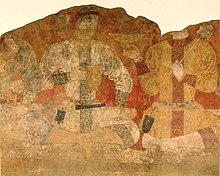Dēwāštič
Dēwāštič († 722 ) was a Sogdian ruler in the early 8th century. He ruled Punjakent from around 706 until his death in 722.
The documents found in 1933 near Mount Mugh east of Samarkand provide important information about himself . These are unique in that they provide information about events in Sogdia from the perspective of the Sogdians themselves and not that of the Arabs who invaded Sogdia in the early 8th century (see Islamic Expansion ).
The documents found there come from the Dēwāštič archive, among others. Dēwāštič called himself “King of Sughd (Sogdia) and Lord of Samarkand”, as the archival material from Mount Mugh shows, although there has been a certain Ghurak in Samarkand since the 710s . When the Arabs invaded Sogdia at the beginning of the 8th century, Dēwāštič and Ghurak submitted at least formally. Dēwāštič is also said to have converted to Islam , but other religious cults continued to exist. He had already taken in the children of Tarkhun, the ruler of Samarkand who had been overthrown by Ghurak. In this context, Dēwāštič also seems to have asserted his formal claim to rule over Samarkand, although the Arabs apparently did not deny this. At least from then on, Dēwāštič, who was still in contact with local Turkish rulers of the region, and Ghurak competed with each other.
719 asked Ghurak for support against the Arabs at the Chinese imperial court of the Tang Dynasty , while Dēwāštič acted still waiting. However, when there was an uprising against the Arab rule in Sogdia in 722, Dēwāštič also joined. The related events have been handed down by the Perso-Arab historian Tabari . As a result, the local Arab governor sent a punitive expedition to Punjakent to stifle the uprising there. Dēwāštič fled with some supporters to Mount Mugh, while a smaller Sogdian force opposed the Arabs, but was quickly defeated. Dēwāštič had to surrender shortly afterwards, with the Arabs massacring the Sogdians and only leaving people alive who could pay for them. Dēwāštič himself was initially left alive, but soon after (as Tabari describes) executed by crucifixion .
Major destruction occurred in the city of Punjakent; Among other things, the city palace was destroyed by the Arabs, whose wall paintings, some of which have been preserved, show the coronation of a ruler (perhaps Dēwāštič himself) as king of Sogdia.
literature
- Frantz Grenet, Étienne de la Vaissière: The Last Days of Panjikent. In: Silk Road Art and Archeology 8, 2002, pp. 155-196.
- Valerie Hansen: The Silk Road. A New History. Oxford University Press, Oxford 2012.
- Robert G. Hoyland : In God's Path. The Arab Conquests and the Creation of an Islamic Empire. Oxford University Press, Oxford 2015, pp. 183 f.
- Boris Marshak: Dēwāštič . In: Encyclopædia Iranica . Volume 7 (1994), pp. 334 f.
- Dewashtich (Diwashini). In: The Oxford Dictionary of Late Antiquity . Volume 1 (2018), p. 477.
Remarks
- ↑ On the finds on Mount Mugh, cf. introductory Valerie Hansen: The Silk Road. A New History. Oxford 2012, p. 129 ff.
- ↑ On the Arab conquest of Central Asia see Hamilton Alexander Rosskeen Gibb : The Arab Conquests in Central Asia. London 1923 ( digitized ).
- ↑ See Boris Marshak: Dēwāštič. In: Encyclopædia Iranica. Volume 7 (1994), pp. 334 f.
- ^ English translation by DS Powers (Ed.): The History of al-Tabari. Volume 24. New York 1989, p. 172 ff.
- ↑ See Valerie Hansen: The Silk Road. A New History. Oxford 2012, p. 136 f.
- ^ DS Powers (ed.): The History of al-Tabari. Volume 24, New York 1989, p. 178.
| personal data | |
|---|---|
| SURNAME | Dēwāštič |
| BRIEF DESCRIPTION | Sogdian ruler |
| DATE OF BIRTH | 7th century |
| DATE OF DEATH | 722 |
